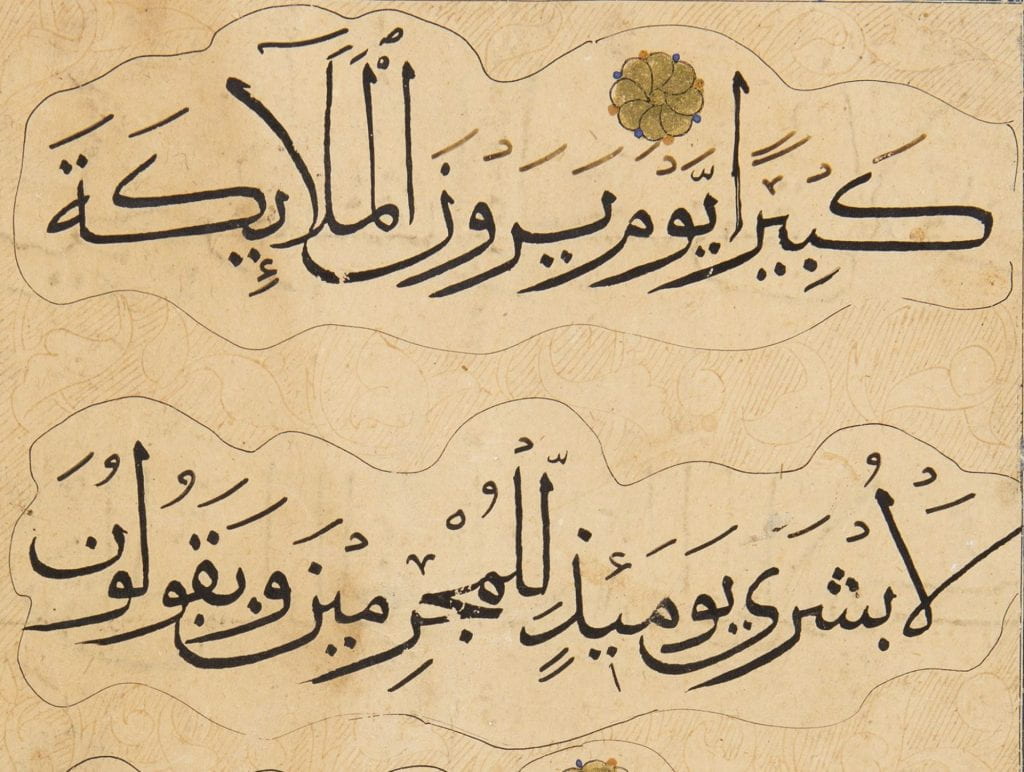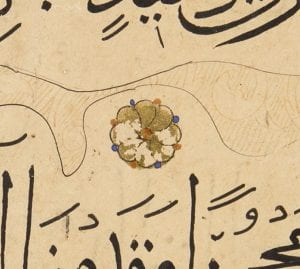MS Mocatta 20: Taking a closer look at fragments of a 14th century Quran
By Sarah S Pipkin, on 30 June 2023
Over the course of Spring 2023 we worked with our UCL Library Services’ colleague Abida S. to take a closer look at MS Mocatta 20: Fragments from the Holy Quran.
I am grateful to have been given this opportunity to take part in a fun project with UCL’s Special Collections team to showcase a 14th century Quran manuscript on the library social media account. The Quran is the holy book for Muslims. To be able to witness first- hand a Quran manuscript from the 14th Century was a special moment. I had this overwhelming feeling of awe and fascination when viewing a piece of history that has been preserved so well for centuries and I was able to read this Quranic Arabic text that is written in an intricate “muhaqqaq” script. This is the same Quranic words that is read today, unchanged.

MS Mocatta 20. Photo by Abida S.
The Holy Quran is the sacred religious book of Islam. In Islam, the Quran is God communicating with mankind. Reciting the Quran is a religious duty for Muslims, especially during Ramadan. It allows you to connect with the Quran’s message and is a rewarding spiritual practice.
UCL’s manuscript, MS Mocatta 20, is thought to date from the 14th and 15th Century and was previously owned by the historian Fredrick David Mocatta. Upon his death in 1905, the Jewish Historical Society of England deposited his collection with UCL. It is unknown how this Arabic manuscript ended up in Mocatta’s collection, but he may have acquired it as part of his historical research.
The manuscript is written in an intricate “muhaqqaq” script in black ink. This majestic type of script was considered one of the most beautiful, as well as one of the most difficult to execute well. A distinct characteristic of this script is that it’s descending strokes end in a straight, sharp point rather than turning upwards in a hook.

First two lines of leaf 2r of MS Mocatta 20
UCL’s fragments include juz’ 19 of the Quran, Surah 25 titled “Al-Furqan, The Criterion”. It is the 42nd Surah to be revealed in the Quran. This juz’, which means part, contains verses 21 to the beginning of verse 62 from Surah Al-Furqan. These particular verses deal with themes of prophethood and resurrection on the Final day of Judgement and the believers’ place in Heaven.

A large, elaborate roundel

A smaller roundel showing signs of wear
There are small roundels on the pages which are used to mark the beginning of each verse. Verse 21 has a decorative page which indicates the start of the juz’ 19 in this surah. These pages are part 19 of the 30 sections of the Quran. This manuscript fragments are written in ink on paper, with colored symbols and gold leaf detailing. It is unknown why these particular pages did not arrive as part of the complete Quran. However, the condition of this manuscript and signs of wear suggest it was regularly read and transported around.

First page of MS Mocatta 20. Photo by Abida S.
I appreciate how I was given access to a Special Collections archive of a 14th Century Quran manuscript. It not only allowed me to interact with a historical, significant religious holy book that is key to my Muslim identity; but it also introduced me to the traditional format of manuscripts from the past and the physical material and finish of one. Access to Quran manuscripts from the past is so important to keep awareness of traditional manuscripts and religion alive and to appreciate and understand the culture of religious manuscripts.
Thank you again to Abida for her research into MS Mocatta 20! Portions of the juz’ have been digitised, and our collections are open to anyone to come and view. For details on how to make an appointment to view items in our collection such as MS Mocatta 20, check out our “visiting us” page.
 Close
Close


